Rats are one of the most annoying pests to deal with, and unfortunately, they’re also one of the most common. Along with causing property damage and being noisy, they can carry dangerous diseases.
The good news is getting rid of rats doesn’t necessarily mean hiring a pricey exterminator. Armed with the right knowledge and products, getting rid of rats on your own is very doable.
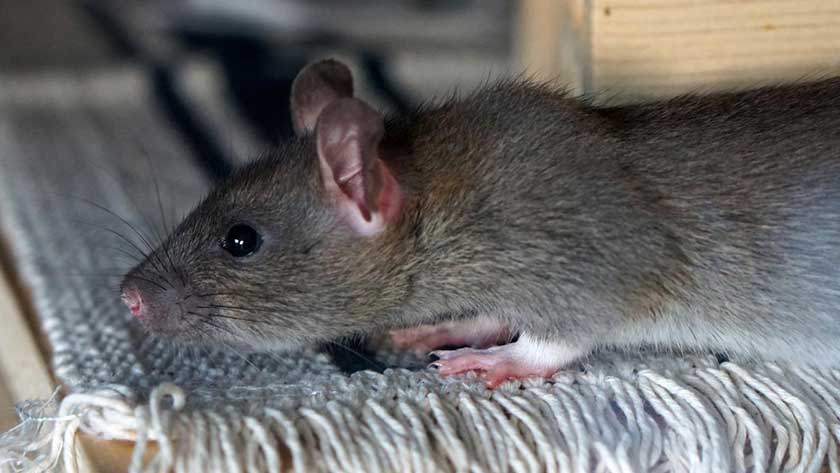
Just keep in mind that rats are not a pest to mess around with. If “do it yourself” methods don’t solve your rat problem, we recommend seeking professional help as soon as possible. In the rest of this guide, we will be focusing on how to get rid of rats FAST on your own.
If you start to see signs of a rat problem in your house, it’s incredibly important to take action as soon as possible, especially if you have children, pets, or health-compromised people in your house. Rats can easily make your house a dangerous place to live, making it unsanitary and threatening homeowners with bites. As mentioned, there are many simple and inexpensive ways of capturing the pests yourself. Traps and poisons can kill rats quickly.
However, there are humane ways of getting rid of your unwanted guests; this guide will also cover some non-lethal rat control options. Make sure you are using these methods in the correct way to ensure effective pest removal and read about the best strategies to get rid of a rat based on its type and where it’s living.
Identification: Signs and Types of Rats
The most common places to have a rat infestation are in homes, apartments, attics, basements, garages, yards, and gardens. There are specific considerations when dealing with rats in certain areas, but before determining which extermination methods are best to get rid of your rat problem, you must know exactly which type of rat you are dealing with.
Identifying the type of rat you are dealing with. It’s fairly common to think that all rats are the same, and should thus be dealt with in the same way, but this isn’t entirely true. If you have rats in your house, you’re more than likely looking at dealing with one of two types of rats: the aggressive Norway rat and the agile roof rat. Certain traps and poison will work for either rat but may need to be placed in different areas or used in different ways to be completely effective.
Norway Rats
Norway rats are often the larger of the two and are often more belligerent.
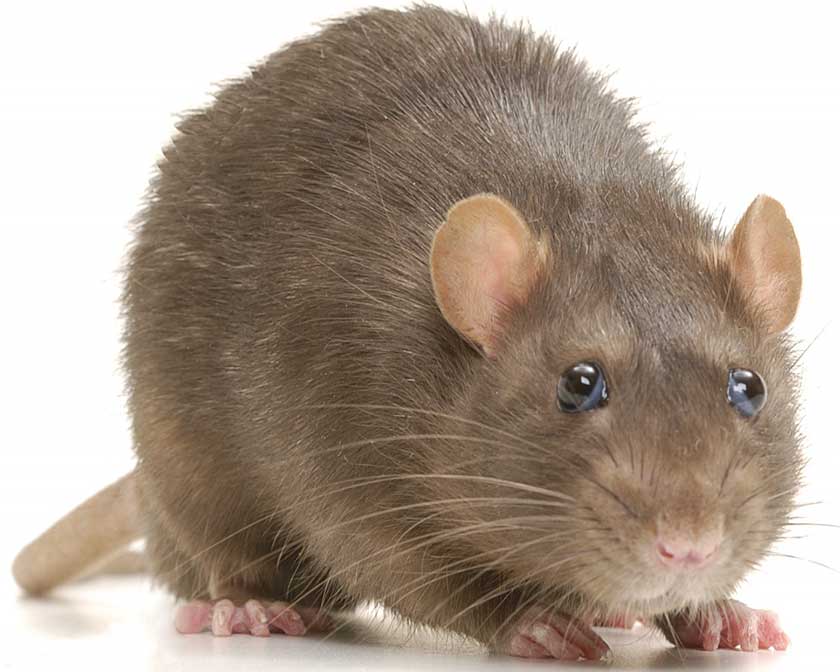
- Brown Norway Rat
They have small, blunt ears and small eyes. Typically the easiest way to identify this rat is to pull its tail over its body; the tail will not reach its head, while the roof rat’s will. Otherwise, the Norway rat’s droppings will have rounded ends, whereas the roof rats will be a bit more pointed. Norway rats prefer to live in burrows, are better swimmers than climbers (although they will climb if need be), and feed on carbohydrates and protein like beans, bread, and meat. Compared to the roof rat, they can be more destructive to the foundation of a home because of their tendency to burrow underground. Norway rats are also more common – they can be found all across the United States.
Roof Rats
Roof rats are smaller than Norway rats, with larger ears and eyes.
As their name suggests, they are more likely to climb and will cause destruction to walls or insulation, especially when they begin gnawing through. Roof rats prefer to feed on foods such as vegetables, grains, and fruit. Compared to Norway rats, they are much less common and prefer to live in warmer, more tropical climates, like on the US coast. They also like to make their nests in palm trees, so homeowners should be sure to keep their trees trimmed. Unfortunately, roof rats are more likely to be afraid of changes in their environment, making them less susceptible to traps and poisons. The best way to capture or kill these rats is to choose methods that will cause the least change to their environment.
How do you know if you have a rat problem?
Rats are primarily nocturnal, so the signs of rats are usually found before the rats are ever seen themselves.
- Droppings: You may have found a large number of rat droppings near a food source. They are the most common way to notice a rat problem. Droppings are usually black or brown in color, with at least one blunt end, although roof rat droppings tend to be slightly more pointed. Fresh droppings are soft, then harden after a few hours; noticing more fresh droppings may mean there is a large number of rats in the area. If you have noticed animal droppings in your house, you must make sure they are rat droppings and not excreted by another pest, like a cockroach or a squirrel, as these would require different methods of extermination.
- Noises: Many homeowners report hearing them running through the walls and gnawing throughout the night. Squeaking or hissing coming from the dark corners of a basement or attic may indicate that there are rats present. Because rats are mainly nocturnal animals, you are more likely to hear their noises at night – if you see or hear them during the day, this could be a sign of a major infestation.
- Nests and Habitats: Depending on the type of rat you’re dealing with, you may find nests or burrows in or around where you live. If your house or patio has suffered some sort of foundational damage, a Norway rat may have made its nest underneath. For homeowners that live in warm and humid regions, roof rats could settle down in palm trees on your property if they haven’t been properly maintained.
Here are the Best Ways to Get Rid of Rats
Mechanical Rat Traps
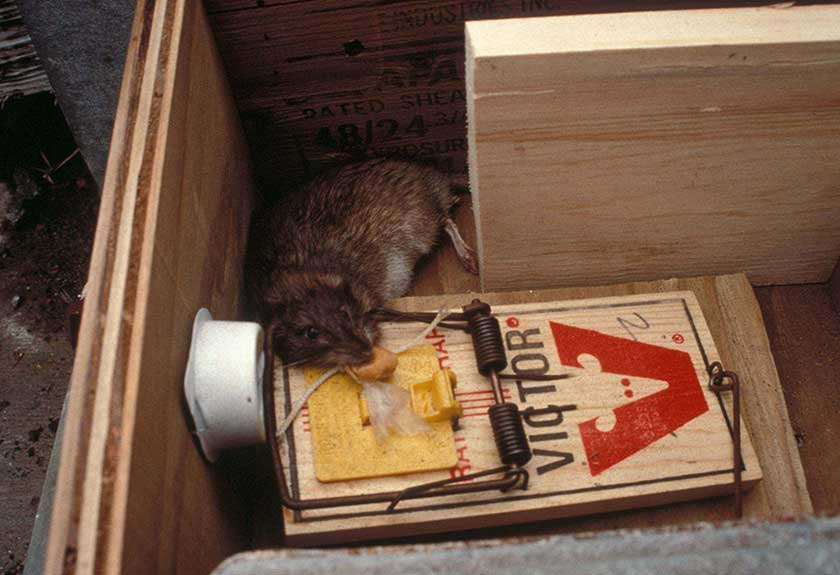
Many people have seen a mouse trap at some point in their lives, even if only in a cartoon, and can easily recognize one. Also known as snap traps, mechanical rat traps are probably one of the easiest and least expensive ways to get rid of rats. With rat traps, all you are required to do is set them, which after some practice only takes a few seconds. It’s a good idea to check them regularly, as a dead rat may attract other pests.
There are many effective and easy-to-use mechanical rat traps, but the two traps listed below are some of the most popular and have the highest rankings. Both are available to purchase on Amazon.
1. Victor Original Rat Trap
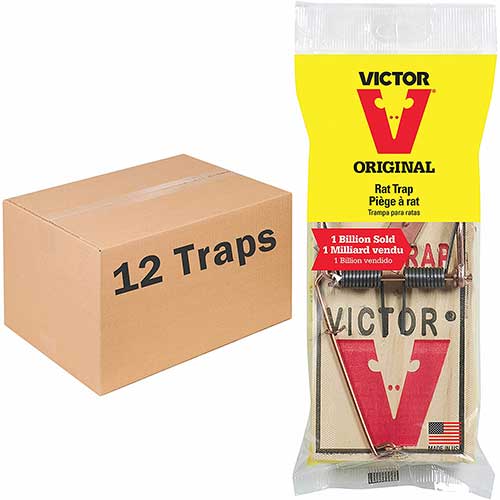
Victor metal pedal rat traps are the most popular traps out there and the traps of choice for many professionals. In fact, these traps are often referred to as “the original wood-based wire snap trap,” and it’s the top-selling snap trap in the world. All of the acclaim is for good reason, too; the Victor trap is simple to use and effective. The trap is tough and can easily trap or even kill any rat that comes into contact with it. To get the best results, be sure to use bait along with the trap, particularly food that the type of mice in your house would prefer (carbohydrates and protein for Norway rats, vegetation for roof rats).
| Pros | Cons |
| Easy to use | Might snap at finger when setting |
| High success rate | |
| Made from environmentally responsible wood |
2. Made2Catch Classic Metal Rat Trap
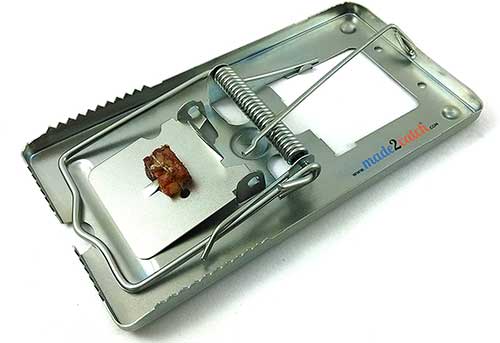
The Made2Catch Classic Metal Rat Traps are made of galvanized metal rather than wood, making them easy to clean and reuse (in addition, the galvanized metal will not rust). It is an improved version of the classic rat trap. This trap is strong and can trap and kill rodents quickly. Some users complain that they are not the simplest traps to set, but the power and efficiency that the trap has makes up for the difficulty. Many were able to find success by using bait with the trap, as long as they tie the bait down and keep ants from taking it away.
| Pros | Cons |
| Made of galvanized metal | Could snap at finger when setting |
| Reusable | |
| Strong and efficient |
Where to set the trap
The best place to set the rat trap is near the location where you’re seeing evidence of rats. If you find droppings or debris that the rat has left behind, that will often be the best place to leave the trap.
As mentioned earlier the two most common types of rats in the United States are the roof rats and Norway rats.
As their name implies, roof rats are climbers and are found near the roofs of homes. For this type of rat, shelves and ledges of attics and garages are great places to set traps. You may also find that garage rafters are a good place to catch them. Norway rats tend to do less climbing than roof rats. We recommend placing traps in corners, along walls or other dark areas where the rats are likely to hide. Again, the best place for a trap is where signs of rats are prevalent, but if you can’t find a specific area stick to the tips listed above.
How Many Traps Do You Need?
Traps are pretty inexpensive, so we recommend buying a somewhat large number of traps and placing them in different locations where you think the rat may travel. Along with increasing the probability of catching a rat, having multiple traps allows you to test different baits. See which trap is set off more often (and that actually catches the rats that run across it) to know which bait would be best to use.
Many people are surprised to find they are dealing with a larger rat infestation than they originally thought. Rats can reproduce quickly, so once you realize you have a problem it’s best to try to solve it as quickly as possible.
Nonlethal Rat Traps
Maybe the thought of dealing with a dead mouse grosses you out more than handling a live animal, or maybe you don’t want to cause harm to the pests, even if they’re unwanted. There are plenty of humane, no-kill traps that capture rats without hurting them.
3. AB Traps Live Humane Rat Trap
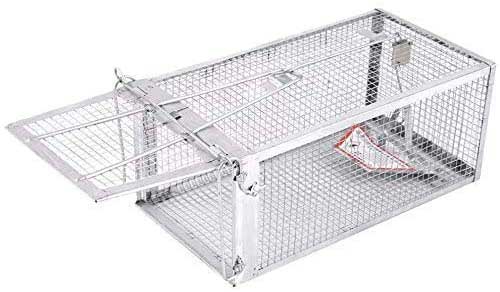
AB humane rat trap is a registered design with the United States Patent and Trademark Office. This cage-like trap does not hurt or kill any animals that it traps; instead, the open door snaps closed when the rat takes the bait, effectively capturing it inside, where it can be set free later. The AB Traps patent claims that once the door is shut, the rat will not be able to escape on its own. In addition, they say that the trap is simple to use, sets up quickly and has a high rate of success.
Related Article: 10 Best Rat Traps
| Pros | Cons |
| Easy to use | Catches one rat at a time |
| Rats cannot escape | Directions may be in Chinese |
| Does not kill rats | |
| Reusable |
4. CaptSure Smart Rodent Trap
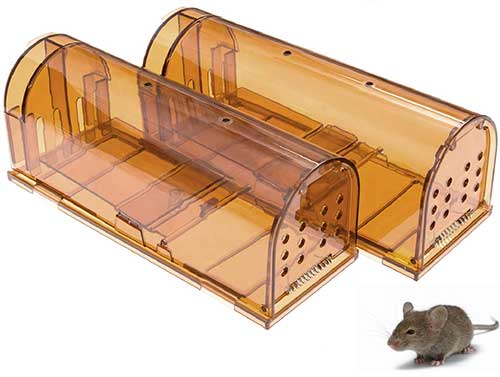
The CaptSure Humane Smart Rodent Trap no-kill trap has been endorsed by humane societies and animal rights organizations worldwide. These traps reduce the amount of human contact needed, meaning a lesser chance of being bitten by a captured rodent (and less chance of contracting a disease) and of getting fingers caught in the trap upon setup. The instructions for the trap recommend using peanut butter as bait, so no rodenticide is necessary.
Related Article: Best Baits for Rat Traps
| Pros | Cons |
| Easy to wash and reuse | Intended only for small- and medium-size rats |
| Safe to handle, even with a rodent inside | Some users say very small rodents can escape |
Glue Boards (For Small Rats Only)
We typically don’t recommend glue boards. While they’re effective for smaller rodents like moles and mice, rats can usually release themselves from the boards over time, either by chewing through them or simply wiggling free. Because the rats aren’t instantly killed when they step on the glue board, it will take longer for them to die, making glue board one of the less-humane options.
In addition to all of that, glue boards may end up trapping animals that don’t need to be caught or sticking to a child or house pet that comes into contact with it. However, glue boards may be an excellent option for rats that have proven to be bait-shy as they are less conspicuous than a typical trap. They are also cheaper and safer to use than snap traps and do not use any form of poison, making them a strong option for houses that have children or pets.
5. Trapper Max Mouse and Rat Glue Boards
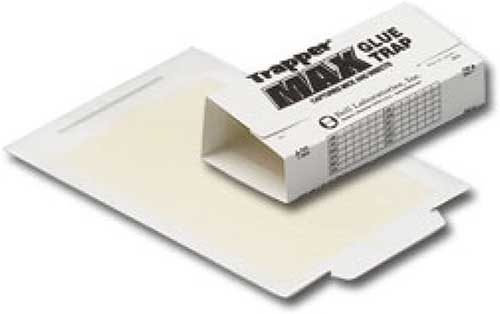
The Trapper Max Mouse & Insect Glue Boards are effective for a wide variety of pests, including insects. The boards can be used flat simply by peeling off the protective layer and laying them on the floor or can be folded into a box shape to better capture rats that fit inside. The traps should be checked often to ensure that captured rats do not have enough time to work their way off of the boards. As a bonus, the traps can be purchased in a peanut butter scent to better entice rats to come into contact with the sticky glue.
| Pros | Cons |
| Peanut butter scented | Do not work well for large rats |
| Can capture a wide variety of pests | Rats can possibly free themselves from the glue |
| Does not use poison |
6. Catchmaster 60M Rat Glue Board
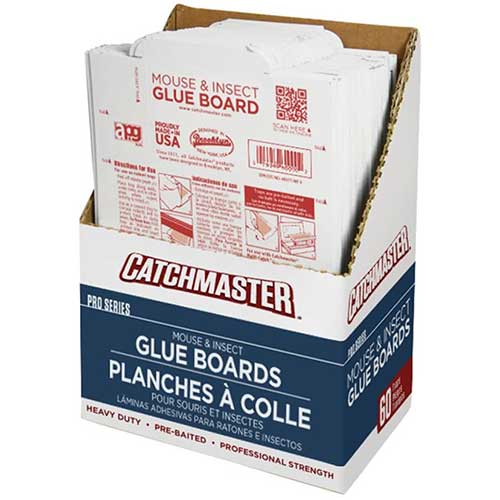
Similar to the Trapper Max boards, the Catchmaster 06M Mouse & Insect Glue Boards can be used flat or folded into a box shape (or tunnel shape, as the description details) to protect the sticky glue side. In fact, many characteristics of these boards are exactly the same as the Trapper Max boards, even down to the peanut butter scent. However, the comments suggest that the “professional-strength adhesive” on the Catchmaster boards may be better suited for large pests, especially if they are kept flat.
| Pros | Cons |
| Peanut butter scented | Sticky adhesive may stick to fingers when handling |
| Easy to use | Some pests have been able to escape |
| Do not use poison |
Rat Poison
Rat poison, also known as rodenticide, is perhaps one of the most effective ways of getting rid of a rat problem in the house as it kills any rodent that comes into contact with it. However, this also means that it can be toxic to humans or animals that are not meant to be harmed by it, and great caution must be taken when using poison to get rid of rats. Be sure to carefully follow all given instructions when using rat poison, or better yet, hire a professional exterminator that knows the correct way to handle toxic chemicals.
Rat poison is often separated into two categories: anticoagulants and non-anticoagulants. Anticoagulants change the way that a rat’s blood clots and the pests will slowly die of internal bleeding. Non-anticoagulants include ingredients that cause damage to the nervous system or circulatory system, particularly the heart. Either poison can be bought in hardware or big-box stores.
7. Just One Bite Rat Poison
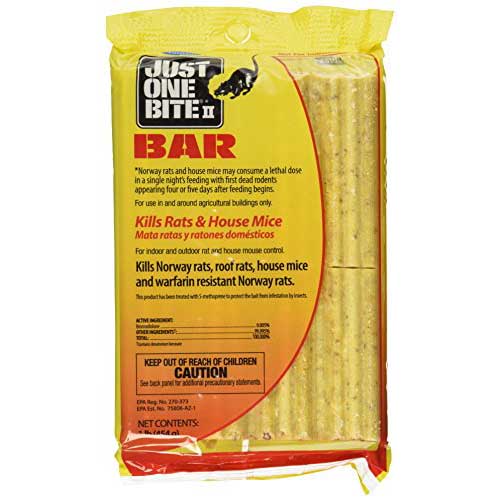
The Just One Bite Rat Killer Bars claim to be effective on both Norway and roof rats. The bars can be used in different ways – some users keep the bars intact and leave them out for pests to gnaw on, others crush the poison and mix it with bait. Just One BIte recommends that bait be placed every 15 to 30 feet in the location of the infestation. Bromadiolone is the primary ingredient used, an anticoagulant that can kill rodents after one feeding. Bromadiolone works even on rats that are resistant to warfarin, another popular rat poison, but may require multiple feedings before actually killing the pests.
The rats may die in random locations and smell. I remember using poison in a barn growing up and the rats died in random holes and ledges and smelled really bad.
Related Article: 12 Best Rat Posions
| Pros | Cons |
| Kills rodents quickly | Toxic when ingested |
| Works to eliminate lots of rats | Should be used carefully around children and pets |
| May need to handle dead rodents |
8. D-Con Rat Bait
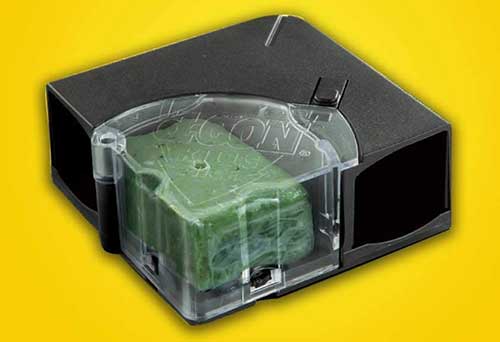
Although the name only mentions mice, the D-Con Ready Mix Bait Bits are considered to be one of the top rat poisons on the market. Like the Just One Bite poison, the D-Con Bait Bits claim to be effective towards warfarin-resistant rodents, but they also say that most rodents can be killed with only one feeding (although dead rats may not show up for a few days). The active ingredient in this poison is Brodifacoum, an anticoagulant similar to Bromadiolone. Brodifacoum is the most toxic poison available to purchase, even more potent than Bromadiolone, and therefore is able to work faster.
Related Article: 12 Best Ways to Get Rid of Mice
| Pros | Cons |
| Highly effective | Highly toxic |
| Works quickly | Pricey compared to other options |
Bait Stations
Bait stations do not trap, but instead simply enclose the rodenticide bait. The rat enters the stations and feeds on whatever has been used as bait, then leaves, where it will die from poison away from the trap. Keeping the rodenticide protected inside a station prevents against accidental contact or ingestion by children and non-targeted animals.
Unfortunately, this may not be the most effective option against getting rid of rats, especially if there is a large infestation. Food contaminated with pesticides may not be attractive to rats as bait – rats have a keen sense of taste which gives them a preference for fresh food. For bait, using fresh food that includes grain-based ingredients (and without rodenticide) is the most attractive to rats, which means that snap traps will often be the more effective option.
At the same time, bait traps may not work for rats, particularly for roof rats, because they present a new object in the usually familiar environment. Rats tend to be neophobic, which means that they are afraid of things that are new, like a change in their environment or food source. This fear is also called bait shyness.
Bait stations would be best suited for houses with children or pets who may be harmed if they come into contact with a snap trap or uncovered rat poison. Being aware of the possible drawbacks can help you to use these products in the most effective way.
9. Tomcat Rat Bait Station
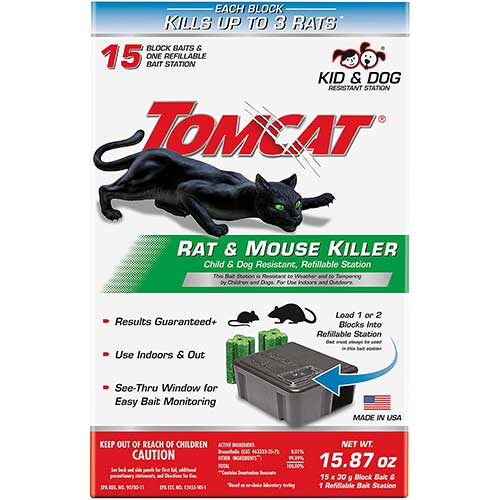
One of the best reasons for using a Tomcat rat bait station is to protect children or pets from contact with toxic rat poison, and the Tomcat Rat and Mouse Killer Refillable Station claims to do just that; it is resistant to tampering from children, animals, and weather, meaning it can be used indoors or outdoors. Each station contains a block with enough poison to kill 3 rats before needing to be refilled. The top of the station has a transparent plastic window, allowing the user to see inside the station when it’s closed.
| Pros | Cons |
| Reusable | Only kills 3 rats before needing to be refilled |
| Safe around most children and pets | Does not trap rats |
| Easy to use |
10. Protecta LP Bait Station for Rats
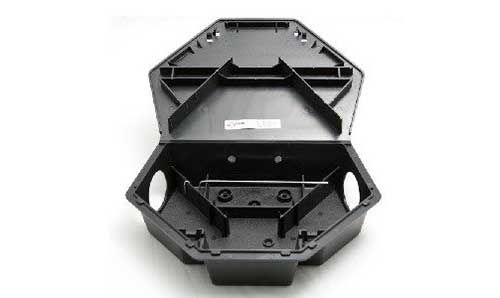
This is a Protecta LP bait station for rats. The “claim to fame” for the Protecta LP Rat Bait Station is its discreetness. The shape of the station has multiple angles, making it suitable for placing in corners, against walls or in tight spaces. Protecta calls the bait station “low-profile,” and fits well into areas that may be too cramped for other stations. The station comes with a key that is used to open it, which may make it more complicated to replace the bait inside but adds a level of protection for homes that have pets or children. It is also fitting to use outdoors as it has a drain system and elevates the bait to avoid it getting wet.
| Pros | Cons |
| Suitable for outside use | Key may make opening a bit more difficult |
| Fits into tight spaces and corners | Does not trap rats |
| Station helps keeps bait away from pets or children |
Rat Repellents
Unless you are already dealing with a rat infestation, rat repellents will keep your house free of rodents before they can even get in. Many of the same products that are used to reduce the size of a rat infestation can be used as repellents as well – placing traps or poisons in areas where rats may like to congregate will help to keep them away. Repellents are usually one of two types: spray or ultrasonic.
Spray repellents are simple to use and often use natural ingredients (like essential oils) that irritate rodents and deter them from entering a house. Unfortunately, there are no regulations placed on spray repellents requiring them to be truly effective. The natural oils used in sprays can be competent in causing rats to turn away if they have an unpleasant scent, but that may mean that the scents are unpleasant to humans as well (for example, garlic). The good news is that when combined with other repellent methods, sprays can end up being sufficient for keeping rats away.
11. Exterminators Choice Mice and Rat Defense Spray
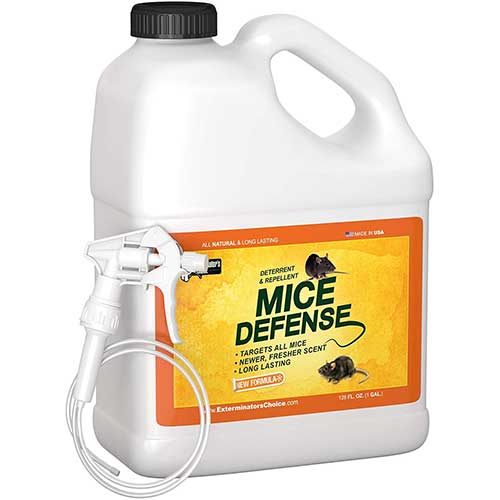
In the product name on Amazon, the Exterminator’s Choice Mice Defense Spray labels itself as “chemical-free” and “safe for children and pets.” In fact, the spray relies on essential oils and other natural ingredients to turn away rodents and has a scent that is not unpleasant to humans. The brand also claims that on top of having a scent that is noxious for rats, their spray irritates rodents’ eyes, which makes them want to keep away from the discomfort. The spray, which comes in a large 1-gallon container, comes with a spray nozzle that makes it easy to use.
| Pros | Cons |
| No harsh chemicals | Might have to use Multiple times |
| Easy to spray | Scent may not be effective after some time |
12. Rodent Natural Rat Repellent Mint Spray
Essential oils show up again in the formula for Rodent Sheriff’s Ultra-Pure Mint Spray – this time, as the name suggests, with mint as the primary scent. This spray claims that it is safe to use around children or pets, or in sensitive areas like a garden or a car. In addition to rats, it also repels mice, raccoons and a variety of insects. Each bottle contains 8 ounces of spray fluid, which the description says will provide 1,000 sprays per bottle, which is particularly useful as the comments say that frequent spraying is needed for the formula to be effective in keeping rodents away.
| Pros | Cons |
| Safe to use around children or pets | Requires multiple sprays to be effective |
| Pleasant scent | Peppermint scent is very strong |
13. T3-R Triple-Impact Rat Repeller
The T3-R Triple High Impact Mice, Rat and Rodent Repeller may be one of the simplest repellents to use to deter a wide variety of pests. This device claims to repel squirrels, as well as rats and mice. This repellent does not use toxic chemicals or unpleasant smells, and will not stick to or close on fingers like glue or snap trap would, making it safe to use in a house with children or pets. In addition, the product seller has a satisfaction guarantee, and many reviews comment on how helpful the seller was if there was an issue with the repellent or if it did not work as expected.
Ultrasonic repellents supposedly emit a very high-pitched noise that rats can hear, but that isn’t audible to humans. The noise is bothersome enough to rats that it will drive them away. On top of that, the sound is also annoying to insects and most products claim that they will prevent insect infestation as well. The major downside to this is that even if it is successful, results are usually temporary as the pests get used to the noise and come crawling back. Just like spray repellents, when ultrasonic repellents are used in addition to other methods, such as using traps, they can be effective in keeping rodents away from a house.
| Pros | Cons |
| Safe around children and pets | Can take some time to be effective |
| Great customer service |
Natural Extermination Methods
If you’re looking for how to get rid of rats naturally this section is for you.
14. Cut off their food supply
One of the best ways to prevent rats from taking over your home or apartment is to take away all incentives of living there. When rats are not able to gather food or find a suitable place to hunker down, they will move on (away from your house) and find a location that will suit their needs.Like most pests, rats love to live in areas where access to food is plentiful.
Be conscious of how you’re storing your food and make sure you clean up properly after meals. Rats are quite good at finding scraps of food. Once they find food they will often carry it back to their nest. By leaving food out just one night you may be providing the rat or rats with a week’s worth of food, so make sure you have a lid on your garbage can, clean up after meals and keep your food in a sealed container.
15. Seal up openings
One of the best ways to prevent rat infestation is to prevent them from getting into your house or apartment in the first place. Do your best to seal up any openings into your house. Rats are able to contort their bodies and squeeze through tight spaces – if rats can find a hole even as small as a quarter, they will likely be able to enter your home or apartment. If they see your home as a place that is difficult to get into and out of they will be discouraged from moving in.
Eliminating shelter sources
Simply put, if rats cannot find a place to live in your home, they will choose to move somewhere else. Eliminating all potential shelters and making your house unsuitable for rats to hide out will not only get rid of any rats that are currently living there but will keep pests from moving in in the future. This can best be done by thoroughly sanitizing the inside and outside of your house. Outside, be sure to remove any potential food sources, like garbage and vegetation, that would attract rats to the area. Indoors, keep dark, tight spaces that rats typically choose to nest in very clean and practice proper storage techniques.
16. Other Natural Repellent Methods
Most other natural repellent methods are used to deter rodents by their smell, and, fortunately for homeowners, not all of them are unpleasant to humans. These products are perfect for homes with children, pets or health-compromised people who may not be able to tolerate being around toxic chemicals. In addition, you may be able to save money on these household products if you already own them.
Essential oils have a variety of purposes and are often included in pest repellent sprays. One of the major benefits of using them to deter rodents is that they have a much more pleasant scent than chemical-laden sprays may have. Peppermint is one of the more popular scents used to keep away pests, and it is often used for insects like spiders and roaches in addition to mice and rats. Although they aren’t as popular, lemon and eucalyptus oils are also said to be effective as rodent repellents.
The scent of ammonia can be useful in scaring rats away from your house as it is similar to the scent of urine. Rats may smell the ammonia and think that a predator is nearby. Some homeowners say that they place their cat’s litter box in an area that rats may be attracted to so that they can smell the urine. However, you may not want your house to have a urine-like scent, and even if you did decide to use ammonia, the rats may eventually realize that there is no danger and invade your house anyway.
Related Article: How to Get Mice in the Walls
17. Mothballs and Rats
Mothballs are commonly found in a home, especially in closets or wardrobes where moths feed on clothing. Some homeowners believe that they are effective in deterring mice as well – mothballs contain chemicals that are irritating to rodents when inhaled or ingested. But these chemicals are toxic to humans and other animals as well and can be especially dangerous to children, pregnant women or health-compromised individuals. At the same time, the rats may be able to ignore the scent if they’ve already hunkered down in your house, and the mothballs won’t be effective in running them off.
When it comes to natural solutions, essential oils would be the most effective, in addition to any preventative measures that can be taken in eliminating food and shelter sources.Rats are a very common problem, both annoying and dangerous, but they don’t have to be difficult to get rid of. If you do not have a problem but would like to keep rats away from your house and your family, there are plenty of preventative steps that you can take to keep them out. But if you do have an infestation, there are a wide variety of ways to capture or exterminate your unwanted house guests, especially if you combine multiple methods. In the worst case, professional exterminators are able to get rid of any stubborn rats that refuse to leave.
Knowing that there are options is the first step to eliminating rats – no matter how big the problem may seem, you don’t have to put up with the pests forever.
Well, that’s it, I hope this guide will help you solve your rat problem. You can learn more about rat behavior here. If you have any questions about rats, don’t hesitate to ask us in the comments below.
My name is Blane and I’m a life-long resident of Southeastern Louisiana. I’ve been working as Pest Control Technician and Inspector for about 1.5 years now.
I’ve worked in many other industries as well, including consulting, managing, as well as at the ground level in fields including Food Service, Corporate Automotive sales, and finance. Whether it be providing counsel, content, or hands-on support; my goal remains to add value to the lives of the people I serve.
If you have any questions regarding pest control, leave them below. I would be happy to help you out in any way I can.

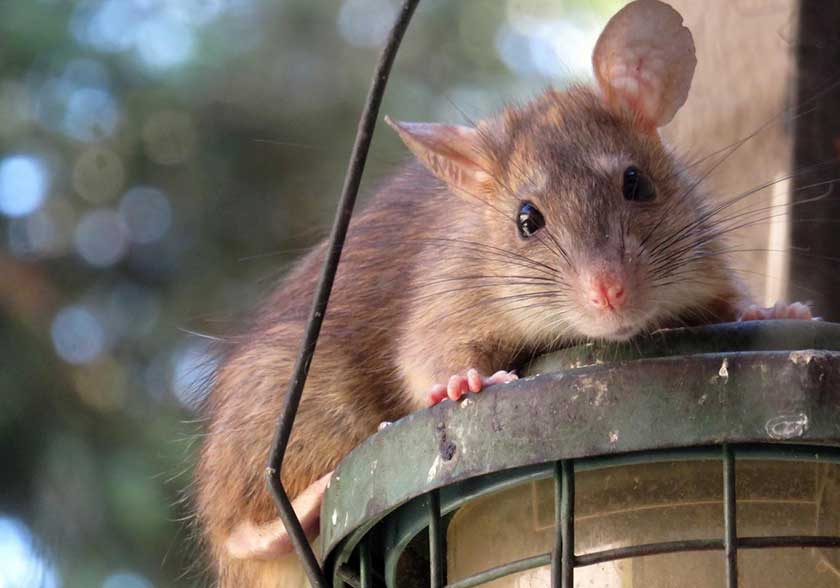
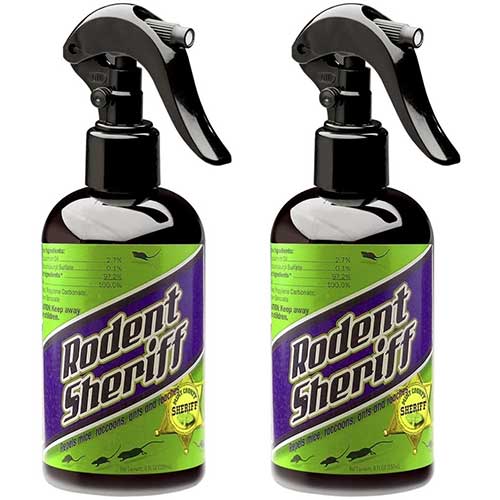
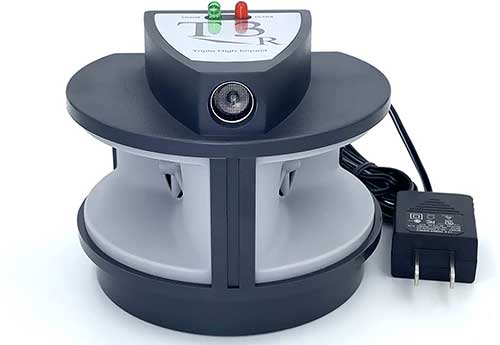
You stated about a contraceptive for rats but you didn’t mention how or what to use for that. We live in San Antonio and have a rat problem, mainly just outside but probably getting into garage attic though we don’t see evidence there…so, I’m trying to deter them without using poisons. In years past we have heard them through the ceiling downstairs/upstairs floor boards And thought they were gone but this year we are seeing them outside, by the bird feeders which we stopped ground feeding and moved the hanging one which has a baffle. We had only killed one this year with the wooden base metal arm using peanut butter. The lu e traps aren’t getting them either though food is missing. Thanks